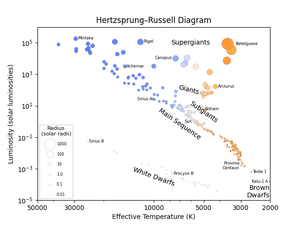Glossary term: Luminosity
Description: Luminosity is the energy output per second from some emitting body such as a star. The most common use is for electromagnetic radiation, in which case the range of wavelengths or frequencies needs to be specified. The radiative energy per second at a specific frequency or wavelength is called "luminosity density". The luminosity across all electromagnetic wavelengths is referred to as "bolometric luminosity".
Other forms of luminosity include neutrino emission or material outflows such as jets.
In astronomical contexts, luminosities are often expressed as multiples of the Sun's luminosity, known as solar luminosities.
Related Terms:
See this term in other languages
Term and definition status: This term and its definition have been approved by a research astronomer and a teacher
The OAE Multilingual Glossary is a project of the IAU Office of Astronomy for Education (OAE) in collaboration with the IAU Office of Astronomy Outreach (OAO). The terms and definitions were chosen, written and reviewed by a collective effort from the OAE, the OAE Centers and Nodes, the OAE National Astronomy Education Coordinators (NAECs) and other volunteers. You can find a full list of credits here. All glossary terms and their definitions are released under a Creative Commons CC BY-4.0 license and should be credited to "IAU OAE".
If you notice a factual error in this glossary definition then please get in touch.
Related Diagrams
Hertzsprung-Russell diagram
Credit: IAU OAE/Niall Deacon
License: CC-BY-4.0 Creative Commons Attribution 4.0 International (CC BY 4.0) icons









